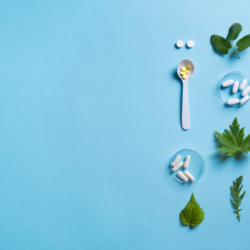Herbal teas are made by macerating, digesting, decocting or infusing plant material in hot or cold water. To extract all the necessary virtues, fresh or dried flowers, stems, leaves or roots can be used. Chamomile, cinnamon, ginger, verbena or even CBD… There are many plants and plant extracts available to create these delicious drinks with a thousand and one benefits. Focus on herbal teas: grandma’s remedies for alleviating and curing the various aches and pains of everyday life.
How do herbal teas work?
Herbal te as derive their therapeutic effectiveness from the presence of various bioactive compounds in the plants used. These compounds play a crucial role in the mechanism of action of herbal teas, enabling them to target and relieve a multitude of ailments.
Bioactive compounds
Bioactive compounds are substances present in plants that have beneficial effects on health. Among the most important are flavonoids, alkaloids, glycosides, saponins and essential oils.
- Flavonoids: These polyphenols are known for their antioxidant and anti-inflammatory properties. They help neutralise free radicals and reduce inflammation in the body. For example, apigenin, found in camomile, is a flavonoid that helps soothe gastrointestinal spasms and inflammation.
- Alkaloids: These nitrogenous compounds often have anaesthetic or stimulant effects. One example is passionflower, which contains alkaloids with sedative and anxiolytic properties.
- Glycosides: These play an important role in metabolism and can have cardioprotective and anti-inflammatory effects. For example, partenelle contains glycosides that help prevent migraines.
- Saponins: These compounds have anti-inflammatory and immunomodulating properties, helping to strengthen the immune system and fight infection. Elderberry is a plant rich in saponins, which are beneficial for immune protection.
- Essential oils: These have antimicrobial, antifungal and anti-inflammatory properties.Eucalyptus and peppermint are examples of plants containing essential oils that are effective in treating respiratory infections and digestive disorders.
Mode of action
The modes of action of herbal teas depend on the bioactive compounds they contain and the way these compounds interact with the body’s biological systems.
- Interaction with cell receptors: Many bioactive compounds bind to specific receptors on cells, modulating biological responses. For example, the menthol in peppermint binds to pain receptors, producing an analgesic and antispasmodic effect.
- Modulation of inflammation: Herbal teas can reduce inflammation by inhibiting pro-inflammatory enzymes or modifying inflammatory signalling pathways. Chamomile flavonoids act in this way to reduce inflammatory reactions.
- Antioxidant effects: The antioxidants present in herbal teas neutralise free radicals, reducing oxidative stress and protecting cells from damage. The polyphenols in green tea are particularly effective in this role.
- Stimulation of the immune system: Certain compounds, such as those found in Echinacea, can stimulate the activity of immune cells, boosting the immune response and helping to prevent infection.
- Relaxes smooth muscles: Herbal teas such as fennel or valerian contain compounds that relax the smooth muscles of the gastrointestinal tract, helping to relieve cramps and aid digestion.
Anti-inflammatory and antioxidant of choice
There are a multitude of plants with antioxidant and anti-inflammatory properties, recognised for their effectiveness in preventing and treating a variety of ailments. Among the most notable are black and green teas, honey, camomile and ginger.
Black and green teas
Black and green teas are rich in catechins, a type of flavonoid with powerful antioxidant properties. These compounds neutralise free radicals, reducing oxidative stress and inflammation in the body. Teas also contain polyphenols, which have anti-inflammatory effects, helping to soothe tissue irritation and inflammation.
Honey
Honey is well known for its antioxidant and anti-inflammatory properties. It contains various bioactive compounds such as flavonoids and phenolic acids. When eaten raw or infused in hot water, honey can soothe sore throats and burns. Its antimicrobial properties also help prevent secondary infections.
Chamomile
Chamomile has been used for centuries for its anti-inflammatory and soothing effects. Chamomile’s main active constituents, such as apigenins and matricins, play a crucial role in reducing inflammation. Infused in hot water, chamomile helps to soothe internal and external irritations, promoting a state of relaxation that contributes to restful sleep.
Ginger
Ginger is a powerful anti-inflammatory and antioxidant. Gingerols, ginger’s main bioactive compounds, have been shown to have significant effects in reducing inflammation and associated pain. Ginger, when infused or eaten raw, is particularly effective in relieving sore throats and improving immune function, thanks to its antimicrobial and antiviral properties.
Passionflower
Passionflower is renowned for its sedative and anti-inflammatory effects. Active compounds, such as flavonoids and alkaloids, help to reduce inflammation and promote a state of calm. By promoting restful sleep, passionflower enables the body to regenerate and strengthen its immune defences against various illnesses.
Prevents and reduces muscle and joint pain
Joint and muscle pain, frequently associated with sporting activities or sustained physical effort, can be effectively prevented and alleviated by various natural methods. A holistic approach includes regular consumption of specific herbal teas, in conjunction with a healthy lifestyle.
Recommended herbal teas and plants
To relieve pain, certain plants stand out for their anti-inflammatory and analgesic properties. Turmeric is renowned for its beneficial effects on inflammation and joint pain. Blackcurrant, meadowsweet, ash and nettle are also effective in improving joint mobility and reducing muscular discomfort. These plants can be consumed in the form of herbal teas, like those found in ARTIPAUSE Tisane. This blend, which is certified organic, is designed to be used as a preventive or curative measure.
The importance of collagen
Collagen, taken daily, plays a crucial role in maintaining joint health and flexibility. This essential component of connective tissue is not only beneficial for the joints, but also helps to maintain the elasticity of the skin, thereby contributing to an anti-ageing effect.
Tips for an integrated approach
To complement the consumption of herbal teas and collagen, we recommend adopting a balanced diet, rich in anti-inflammatory nutrients, and maintaining a healthy lifestyle, including restful sleep and regular mobility training. These practices make a significant contribution to preventing muscular and joint pain, while encouraging faster, more effective recovery after physical effort.
Fighting fatigue
Take the example of Yerba mate from Laboratoires Iphym: this is an infusion made from the leaves and twigs of the Ilex paraguariensis plant. Traditionally, the leaves are dried and then soaked in hot water to make tea. What’s more, with 85 mg of caffeine per cup, yerba mate contains less caffeine than coffee but more than a cup of tea. So, like any other food or drink containing caffeine, it can boost your energy levels.
Pop CBD infusions are also a great way to relax and improve your mood. They can help reduce stress and anxiety, so you can get a good night’s sleep. As a result, you’ll feel less tired.
Facilitates and improves digestion
Having trouble digesting food? Plants will be your best friends. As well as having a relaxing effect on the body, they aid digestion. The Pukka brand offers herbal teas for digestion to help you digest better after a heavy or heavy meal (such as those eaten over Christmas). Are you constipated? Herbal teas are also an excellent remedy! In fact, some Herbesan products, such as HERBESAN Transiphyt Organic Laxative Herbal Tea, contain natural ingredients that aid digestion and also have laxative properties. The herbal tea we’ve just mentioned is made with fennel, rhubarb, chicory and marshmallow, all of which help with digestion. In fact, have you ever tasted the herbal teas created by Pukka or Vitaflor?
Digestive problems are common and can include symptoms such as bloating, abdominal cramps and indigestion. Herbal teas offer a natural and effective approach to relieving these discomforts. Among the plants most commonly used for this purpose are chamomile, peppermint and fennel.
Chamomile
Chamomile (Matricaria chamomilla) is widely recognised for its anti-inflammatory and antispasmodic properties. It contains bioactive compounds such as flavonoids (notably apigenin) and sesquiterpenes (such as chamazulene), which help to reduce inflammation and soothe muscle spasms in the gastrointestinal tract. Studies have shown that drinking chamomile tea can reduce the symptoms of indigestion, nausea and abdominal pain. It also promotes relaxation, which can indirectly improve digestion by reducing stress.
Peppermint
Peppermint (Mentha piperita) is another plant commonly used for its digestive benefits. Its main active compound, menthol, has carminative and antispasmodic effects. Menthol helps relax the smooth muscles of the gastrointestinal tract, which can relieve abdominal cramps and facilitate the passage of gas, thus reducing bloating. Peppermint tea is particularly beneficial for people suffering from irritable bowel syndrome (IBS), as it can ease pain and improve digestive comfort.
Fennel
Fennel (Foeniculum vulgare) has been used for centuries to treat various digestive disorders. It contains essential oils such as anethole, which have carminative and antispasmodic properties. Fennel helps expel intestinal gas, reducing bloating and abdominal pain. It also stimulates the secretion of gastric juices, promoting more efficient digestion. Fennel tea is also known for its beneficial effects on infantile colic, providing relief for infants suffering from abdominal pain.





